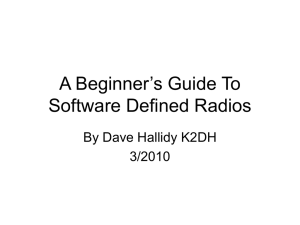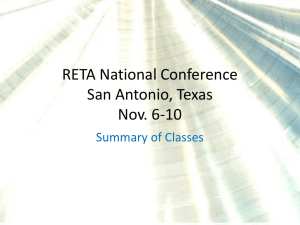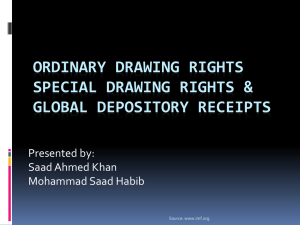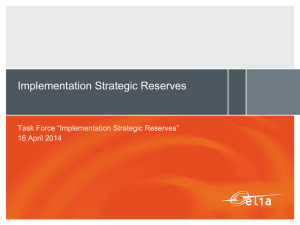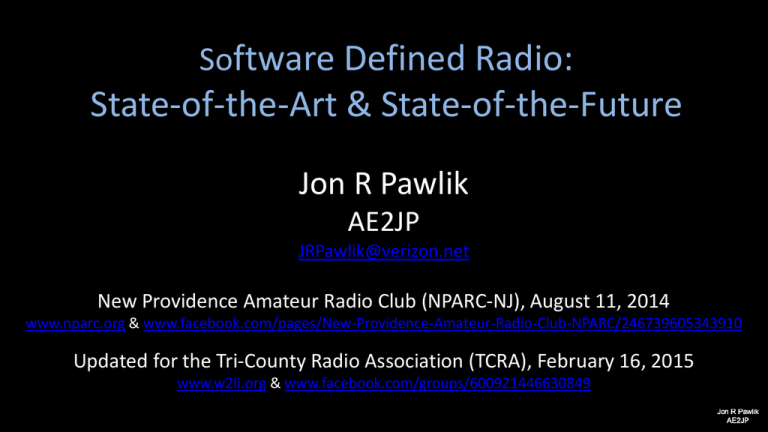
Software Defined Radio:
State-of-the-Art & State-of-the-Future
Jon R Pawlik
AE2JP
JRPawlik@verizon.net
New Providence Amateur Radio Club (NPARC-NJ), August 11, 2014
www.nparc.org & www.facebook.com/pages/New-Providence-Amateur-Radio-Club-NPARC/246739605343910
Updated for the Tri-County Radio Association (TCRA), February 16, 2015
www.w2li.org & www.facebook.com/groups/600921446630849
Software Defined Radio: State-of-the-Art & State-of-the-Future
This presentation was inspired by two, standing-room-only forums at the 2014 ARRL National
Centennial Convention, but the content extends well beyond those two presentations alone:
“SDR Advances and the Future of SDR”
by Stephen Hicks, N5AC, FlexRadio VP of Engineering
Amateur use of Software Defined Radio (SDR) has gained substantial momentum in the last few years. Many new and
exciting SDR radios are being introduced every year from a variety of vendors. This session explores new, emerging
and future SDR technologies, demonstrating the secrets behind the technologies, how they advance Amateur Radio,
and how the audience can use each technology to increase their operational effectiveness. The session concludes
with an exploration of where SDR technology is likely to take Amateur Radio and what it means for today’s operators.
“Software Defined Radio for Beginners”
by Stephen Hicks, N5AC, FlexRadio VP of Engineering
This introduction to Software Defined Radio (SDR) explores the architectural and operational differences in traditional
and software defined radios. The early foundations of SDR are used to briefly demonstrate the basics of SDR.
Following this, an exploration of different SDR technologies and their capabilities will be discussed with an emphasis
on educating the audience on how the technologies work and how they can use each technology to achieve their
operational (on the air) goals.
Software Defined Radio: State-of-the-Art & State-of-the-Future
The ARRL forums were not recorded. HRN by Gary Pearce KN4AQ conveys their flavor:
Ham Radio Now Episode 36: FlexRadio - SDR Architectures for Digital Communication
with Stephen Hicks, N5AC, FlexRadio VP of Engineering, http://youtu.be/xCdxAmMsoC4
Ham Radio Now Episode 61: Software Defined Radio Basics with FlexRadio
with Greg Jurrens K5GJ, FlexRadio VP of Sales & Marketing, http://youtu.be/yj44qGVjikw
Ham Radio Now Episode 115 from the DCC: FlexRadio 6000 Update
with Stephen Hicks N5AC, FlexRadio VP of Engineering, http://youtu.be/UyXZn5ppYpk
Ham Radio Now Episode 146: FlexRadio 6300 Intro at Dayton
with Greg Jurrens K5GJ, FlexRadio VP of Sales & Marketing, http://youtu.be/SQkaLJiK92w
Ham Radio Now Episode 164 a&b: FlexRadio Open API & Waveform API at the DDC
with Stephen Hicks N5AC & Steve Bible N7HPR, http://youtu.be/LuWaStl0GgI & http://youtu.be/lOvBo6Lq_Jk
Ham Radio Now Episode 187: The “Accidental” Company; The Making of FlexRadio at the DDC
with Gerald Youngblood K5SDR, FlexRadio Founder, President & CEO, http://youtu.be/HBlkinewdHM
What Is A Software Defined Radio?
• Modulation and Demodulation modes in software, so they are
changeable and new ones can be added.
• Signal Processing in Software, so it is changeable and expandable.
• Control Surface, whether a computer display or physical
encoders, is Reconfigurable in software.
• Can Add New Features and Capabilities with new controls to
operate them completely in software.
• Radio is Controlled by Software and is very likely networked. An
API may be available.
What Are The Benefits Of A Software Defined Radio?
• Everything previously mentioned is reprogrammable in software. Flex RF
Tracking Notch Filter™ is one example. Others later.
• Added features and added receivers only require more processing power,
not physical components.
• “Small Pipe” designs allow full receive and transmit operation from
smartphones or tablets, as well as computers.
• Tremendous dynamic range makes AGC and variable gain obsolete.
• Ideal component simulation with better performance. Example: Analog
filters are ~2-30 poles. Digital can be ~100-2000 poles. See next slide.
• FPGA (Field programmable gate array) designs Massive computing
power Sophisticated, high-performance designs. See following slide.
Digital Brick Wall SSB Filter: A Nearly Perfect Shape Factor
The digitallyimplemented Flex5000 2.8 KHz wide
SSB Filter shows
nearly ideal “brick
wall” skirts
compared to
analog designs.
The top of the
curve is nearly flat
compared with a
12 dB hump in one
analog design.
Computing Power Cost Versus Time And Technology
The Flex-6700 Xilinx Virtex-6 FPGA technology is far more cost effective
per GFLOP of processing power than a state-of-the-art desktop PC!
Transceiver And Receiver Architectures
• Multi-Conversion (Triple Or Dual Conversion Superheterodyne)
Car radios; TVs; Older Scanners; Elecraft K2 & K3 transceivers; most Icom, Kenwood, TenTec and Yaesu transceivers ($100-$12K)
• SDR VHF/UHF >1 MHz Bandwidth Digital Receivers And Transceivers
DVB-T Dongles [R820T or E4000 receiver, RTL2832U USB demodulator] ($15), HackRF
transceiver ($299), usable with the Ham It Up v1.2 Upconverter ($45 + optional $20 case)
• SDR Direct Conversion (One Analog Down Conversion To “Audio” Baseband)
Flex-5000 ($2,799 discontinued), Elecraft KX3 ($1K) optional PX3 panadapter ($500)
• SDR Direct Sampling With A “Large Pipe” Interface (Sampling At Antenna)
TAPR HPSDR (~$2K-3K), TAPR Hermes ($895), Apache Labs ANAN-100B ($1850), HiQSDR
• SDR Direct Sampling With “Small Pipe” Interface VERY Powerful FPGA
Flex-6300 ($2,499), Flex-6500 ($4,299), Flex-6700 ($7,499)
Multi-Conversion (Triple Or Double Conv Superheterodyne)
The diagram shows
Triple Conversion stages
which have three
sources of distortion.
Regarding the Icom IC7600 (below), the Icom
website states: “When
compared to a typical
triple-conversion system,
the double-conversion
system is more difficult to
implement, but it
dramatically reduces
signal distortion and
provides a high-fidelity RF
signal to the DSP
processor.”
VHF/UHF >1 MHz Bandwidth Digital Transceivers & Receivers
A category for SDR things not easily classified, cell phone towers, too.
•
•
•
DVB-T USB dongles, originally designed for European digital TV,
cover 30-50 MHz to 1.2-2.2 GHz with 2.8 MSPS rates, 8 bit.
The HackRF covers 10 MHz to 6 GHz with 20 MSPS rates, 8 bit.
Mike Ossman SDR video series at: http://greatscottgadgets.com/sdr.
The Ham It Up board v1.2 upconverts signals by 125 MHz,
providing coverage of the ham HF bands for the above units.
Great for security studies, Wi-Fi, Bluetooth, GPS, 4G, radar, police, fire,
800 MHz trunking, aircraft ACARS flight paths, NOAA weather maps,
radio astronomy, FM radio, rig monitoring and much more!
Aircraft Flight Tracking: A ‘Gee-Whiz’ Application Of $15 DVB-T Dongles
HDSDR Software Runs With Almost All SDR Hardware
The top waterfall display scrolls
upward with time displaying
signals in colors ranging from
blue to red for increasing signal
strength. Below that is spectral
amplitude versus frequency. On
the bottom right these displays
are repeated with different
frequency and time scales.
An S-Meter and frequency
readouts (L0 and Tune) are on
the middle left. Below that are
various buttons and sliders, some
of which open drop-down
menus, thereby accessing the
transceiver control functions.
SDR Direct Conversion (One Down Conversion To Baseband)
With only one
analog down
conversion before
digitizing the
signals, there is less
opportunity to
introduce distortion
than in the multiconversion design.
The Elecraft KX3
(left) and Flex-5000
(right) are examples
of Direct Conversion
SDRs.
Sherwood Engineering IMD Tests On Four Transceivers
Two frequencies separated by
200 Hz induce Intermodulation Distortion (IMD)
spurs at second and third
harmonic frequencies.
As the number of conversions
decreases from three (ur, lr) to
two (ll) to one (ul), the spurs
lie further and further below
the main peak amplitude.
Not shown is the similar
reduction of the phase noise,
important for reducing
background noise from strong
adjacent signals.
SDR Direct Conversion (One Conversion To Baseband)
A (recently-discontinued) Flex-5000 is shown on display
at the ARRL Testing Labs. It covers 10 KHz to 60 MHz.
A Firewire interface transfers data with sampling rates
of 192 KHz per receiver to the computer. Sometimes
sufficient computer processing power or Firewire
interface incompatibilities are issues.
An Elecraft KX3 covers 310 KHz to
54 MHz + 2m with dual receive
over +/- 15 KHz. Its optional PX3
Panadapter can span up to 200
KHz. A computer is not required,
however receiver IQ outputs are
available to drive a computerbased audio interface and the PX3.
SDR Direct Conversion Receive Simplified Block Diagram
This illustrates down-converted, baseband
IQ signals for the SDR being generated by
analog hardware. Hardware following this
converts them into the digital domain, most
often sampling at 192 KHz or 96 KHz:
•
A pair of ADCs is connected to a DSP or
FPGA within the box for full local analysis
(Elecraft KX3),
•
The outputs of digitizers within the box
are sent to a computer over USB,
Firewire (Flex-5000), or Ethernet, OR
•
Very frequently a stereo audio interface
attached to a computer digitizes the
signals (a secondary Elecraft KX3 mode).
Elecraft KX3 Block Diagram (SDR Direct Conversion)
Unlike many other Direct
Conversion SDRs, the highperformance Elecraft KX3
incorporates a powerful
ADSP-21479 32-bit floating
point DSP and an 18F87K22
MCU so it can work
independently of a PC.
Many designs stop at the IQ
signals relying on an audio
interface, the PC and a
program such as HDSDR for
the digital signal processing.
The KX3 can do that too,
having receive IQ outputs for
a PC and the PX3 panadapter.
SDR Direct Conversion Characteristics
• Greatly improved linearity compared to Superheterodyne designs.
• Distortion is minimized with only one mixer. The clear signal sounds better
and creates less operator fatigue since it has less in-band distortion.
• They have a high dynamic range and lower phase noise.
• The panadapter displays reasonably-wide bandwidths up to 192 KHz.
However, Direct Sampling designs are capable of far wider bandwidths.
• They require small amounts of power. They excel in portable applications.
• Near-in images can’t be rejected with traditional band reject filters.
• Specialized Automated WBIR (Wideband Image Rejection) software
eliminates the image rejection problem, nulling images to the noise floor.
Direct Sampling (No Analog Conversions-ADC At The Antenna)
In SDR Direct Sampling
designs, the signal is
digitized at the antenna,
so there are no analog
conversion stages to
introduce distortion.
Processing of the data
may be at the computer
(“Large Pipe”) or within
the box (“Small Pipe”) .
The Flex-6700 (shown
above) is a Direct
Sampling “Small Pipe”
transceiver, the current
state-of-the-art.
SDR Direct Sampling With A “Large Pipe” Interface
TAPR (Tucson Amateur Packet
Radio) HPSDR boards (upper left)
were integrated into one TAPR
Hermes board (upper right) for
cost reduction. The power
amplifier, LPF, antenna tuner/
switching board is not shown.
An Indian company, Apache Labs,
now manufactures the TAPR
Hermes board, later
incorporated into the ANAN100D (below), and advanced
spinoffs such as the Angelica
board and ANAN-200 series.
TAPR Hermes Block Diagram (Direct Sampling “Large Pipe”)
The TAPR Hermes 8-layer PCB is
full-duplex, covering 10 KHz to 55
MHz, supporting 7 independent
receivers each displaying 48, 96
or 192 KHz of spectrum. It uses a
122.88 MHz master clock for a
16-bit ADC.
The “Large Pipe” carries a high
data rate to the computer for
analysis, display and control.
Altera EP3C40Q240C8N FPGA
code can be updated via Ethernet.
The power amplifier, LPF and
antenna tuner/switching board is
available separately.
SDR Direct Sampling With A “Small Pipe” Interface
The Flex-6000 series covers 30
KHz to 72 MHz + 2m with one or
two 345 MSPS 16-bit ADCs and
2 to 8 slice receivers covering
bandwidths up to 14 MHz each.
A powerful Xilinx Virtex-6 FPGA
performs DSP functions on board:
• A “Small Pipe” of ~0.5 MBPS
flows to the PC to display the
graphic interface and provide
control functions,
NOT a “Large Pipe” of:
• 77 MBPS to display and
process 1 MHz bandwidths
• 770 MBPS to display and
process 10 MHz bandwidths.
Flex-6000 Series Block Diagram (Direct Sampling “Small Pipe”)
The Gigabit Ethernet
interface rapidly reprograms the Xilinx
Virtex-6 XC6VLX130T
FPGA and the TI
TMS320C6A8167 DSP.
However, only a “Small
Pipe” of ~0.5 MBPS is
needed to display the
real-time graphical
interface and provide
control functions for a
smartphone, tablet or
a computer.
Direct Sampling Characteristics “Large Pipe” And “Small Pipe”
• Signal Distortion is minimized with the ADC at the antenna, yielding the best
signal clarity of any design.
• N-Receivers and N-Panadapters with widely-varying bandwidths are available.
We can view more bands with more receivers.
• The Dynamic Range is extremely high, allowing operation in the worst conditions.
• We have Extreme Flexibility through reprogrammibility. It is the ultimate SDR, as
benefits continue to accrue into the future with upgraded software.
• Additionally, the low data rates of a “Small Pipe” design allow operation from
smartphones and tablets, as well as reduced load upon a connected computer.
• Direct Sampling transceivers are technically challenging to design.
Sherwood Labs Receive Performance Ranking - 12/9/2014
Rank
Company
Price
Design
Noise Floor
Sensitivity
LO Noise
Dynamic Range 3rd Dynamic Range 3rd
Model
Architecture
[dbM]
[uV]
[dBc/Hz]
Wide Spaced [dB] Narrow Spaced [dB]
1
FlexRadio
$7,499
SDR
-118
2
145
99
108
Flex-6700
-135*
0.25*
155
2
Hilberling
$15,168
Superhet
-128
0.45
144
105
105
PT-8000A r2.0
Triple Conv
-141*
0.11*
149
3
Elecraft
$1,140
SDR
-123
0.9
144
105
104
KX3
-138*
0.09*
4
Yaesu
$5,700
Superhet
-123
1.1
135
104
101
FT DX-5000D
Dbl/Trpl Conv
-141*
0.13*
5
Elecraft
$2,540
Superhet
-130
0.33
138
104
101
K3
Triple Conv
-138*
0.19*
6
Microtelecom
$1,000
SDR
-123
0.8
147
99
99
Perseus Receiver
-125*
0.6*
7
FlexRadio
$2,799
SDR
-123
1.3
123
96
96
Flex-5000A
-135*
0.3*
8
Ten-Tec
$4,000
Superhet
-127
0.75
126
95
95
Orion II
Triple Conv
-133*
0.3*
*Measured with the preamplifier on, set to maximum gain.
Transceiver output powers range 100 to 200 watts, except the Elecraft KX3 which is 10 watts. The optional Elecraft KXPA100 100 watt amp costs $750.
Performances and prices are specified assembled with one optional roofing filter, no optional antenna tuners. The Microtelecom Perseus is receive only.
We Are Going Mobile And Want To Take Our Fun With Us!
In April 2012 50% of India’s Internet traffic became
mobile. USA lags their numbers by about two years.
Direct Sampling “Small Pipe” SDRs support powerful
networking. The “Small Pipe” keeps the bandwidth
manageable for smartphones and tablets. An iPad
has already been integrated with the Flex-6000’s.
A friend calls to say that Christmas Island station you
have been after is on the air NOW! Try to rush home
in time? NO! Work them from your smartphone!
In the future complete station control will be
integrated into the SDR FPGA: linear amplifier control;
antenna switching, tuning and rotation; logging
software; etc. An API is already in place.
Contest Support And DX Chasing
Which bands are open and active? Watch them
all with eight broadband spectral displays! A
strongly-tuned antenna such as a SteppIR is only
down 10 dB off-band. Still plenty of signal for all!
Found that rare DX station calling CQ? You
have to QSY by the optimal amount to work it.
Open a waterfall display to determine their
reply strategy:
• Offset by a fixed frequency? Go there.
• Reply to the strongest station? Wait on their
frequency until they finish.
• Rotate circularly between frequencies? You’ll
know which one is next.
Auxiliary Interfaces And Remote Operations
The most universal complaint about SDRs which require a computer
regards their slow, [mouse] “clicky” interface:
• At least two large contesting groups are devoting major engineering
resources to contest-grade, nimble, efficient-workflow interfaces for
Flex-6000 series SDRs. They have not made their results public!
• FlexRadio sells a FlexControl USB knob with three buttons, sometimes
used in pairs by contesters.
• Contesters use Hercules USB DJ controllers as speedy SDR interfaces.
• The Elecraft K3/0-Mini + Remote Rig RRC-1258MkIIS boxes replicate the
K3 front panel over the Internet. One company leases their (high-priced)
antenna/K3 farm with them www.RemoteHamRadio.com. Similar
physical SDR controllers (contest grade?) and SDR farms will be coming.
• http://websdr.org lists ~75 Internet-based, web browser-driven SDR
receivers which permit simultaneous users to listen to and tune them.
Phoenix Thunderbird ARC 2014 ARRL Field Day: Best Ever!
Operating more than one
transmitter per band on Field Day
is a challenge. Phase noise of
transmitters and the receiver
combine to elevate the noise
floor of the receiver unacceptably.
Low phase noise SDRs can
mitigate that problem.
PTARC ran 4A: One Flex-6700 and three Flex-6300’s. Respective phase noises of -148 dBc/Hz and
-140 dBc/Hz allowed a huge reduction of the in-band noise. The screen shot is from the Flex-6700
running CW. It, a (literally) red-hot PSK31 Flex-6300 and an SSB Flex-6300 are all on 20m, each
running 100W with antennas within 400 feet of the others. The PSK31 station 40m Carolina
Windom at 65 feet was inside ~3 wavelengths of the CW station 80m Carolina Windom also at 65
feet. The CW station saw ZERO increase in the noise floor outside +/-20 KHz of the PSK31 signal!
Baldock UK Monitoring Station: An Invitation To Innovation
by Michael Wells, G7VJR, QST August 2014 p. 99
Also see http://stakeholders.ofcom.org.uk/binaries/enforcement/spectrum-enforcement/baldock.pdf.
Over the past decade or two, we have become experts in dealing with
interference by using increasingly elaborate DSPs in our receivers that help us
operate with the context of man-made noise and congestion. But we have
only just begun to explore the possibilities of DSPs right at the input—that is,
DSP sampling directly from an antenna (i.e. Direct Sampling). Now that we
have the computer power at our disposal, this is becoming a hot topic.
The possibilities of this receiver architecture are remarkable. I was lucky
enough to tour the UK’s radio monitoring station at Baldock, Cambridgeshire,
part of a network of listening posts that can be used to combat spectrum abuse, including on the HF bands.
It has the capability of direction-finding signals, and through international coordination this can lead to fast,
accurate location of rogue transmitters.
To my surprise, the antenna farm for the Baldock station is only a small field of ground-mounted monopoles!
Each is connected to an independent DSP receiver and then to a computer. The timing and phase differences
are analyzed in real-time, and then displayed as traces on a two-dimensional plot of azimuth and elevation.
This technology is within the reach of radio amateurs, an extremely powerful resource for our purposes.
Thoughts On Signal Processing
Power Amplifier Drive Adaptive Pre-distortion
Power amplifiers are one of the most non-linear components in modern transceivers.
Analog LP filtering is required to meet FCC spurious emission regulations. If the I/O
transfer function is measured, it is possible to pre-distort the input to linearize the
output. HPSDR Pure Signal® developed by NR0V is the first iteration. Some speculate
that LP filters may disappear. See http://video.openhpsdr.org/HRF2014/PureSignal1.2.mp4.
Higher Average Output Power On SSB Transmissions
SSB transmissions go out with 4.5 to 5 dB less average power than CW. Most voice
compression and other audio processing schemes which significantly increase the
average output power leave the audio sounding unacceptably artificial and mechanical.
W9CRB provided FlexRadio with a new algorithm which they have coded and
incorporated into the Flex-6000 series. It provides a 2.5 dB average power increase
without sounding artificial.
More Thoughts On Signal Processing
Receive Antenna Array Processing
Since the Flex-6700 has two ADCs, the inputs of two vertical monopole antennas can be
combined in appropriate phases to provide a directional receive. Alternately, phase
differences could provide directionality data for each signal received. An experimental
version of HPSDR was written which does that. A second transmitter would allow
directional output. How about a skimmer with directional information?
A Digital Voice Skimmer
Digital voice should be of sufficiently good quality for voice recognition tools. How about
building a voice skimmer, similar to a CW skimmer? The fact that amateurs repeat
information such as callsigns could improve the SNR.
An Everything Digital Skimmer
It should be possible to identify most all digital modes (PSK31, JT65, JT9, Olivia, Packet,
RTTY, Hellschreiber, MFSK16, SSTV, BPSK, APRS, etc.) and decode them automatically.
Thoughts On Noise And Interference Reduction
Keeping The Correlated Data
A separate antenna can be connected to each of two ADCs, both monitoring
the same frequency. Actual received signals should be completely correlated.
Uncorrelated components can be discarded as noise for a 3 dB SNR
improvement.
Discarding The Correlated Data
If one ADC monitors a signal source and the other monitors a quiet portion of
the band, then the signals should be completely uncorrelated. Correlated
components would arise from broadband noise such as lightning, atmospheric
disturbances, solar events or certain types of man-made interference. The
correlated components can be discarded to improve the SNR.
MIMO, Direction Finding And Beam Steering Musings
Multiple Input Multiple Output (MIMO) with digital domain phasing
is ripe for amateur exploration, but expensive. A 4-square for
directional receive has been built with toy-like DVB-T dongles for
$60. A 4 x Flex-6500 4-Square costs a hefty $17.2K. Can we build
four inexpensive, high-performance transceivers supporting only one
slice receiver and transmitter each?
The HiQSDR is a Direct Sampling “Large Pipe” with a reasonablypriced Altera EP3C25Q240C8N FPGA, covering 30 KHz through 62
MHz using a 125 MHz 14-bit ADC and DAC (but 16 bits are nicer!). The data rate is 46.08 MBPS for a 960
KHz BW. Is it much cheaper than the $895 TAPR Hermes? Is it good enough? Combine units for
a Field Day 4-Square? See http://hiqsdr.com/hiqsdr-wiki/, http://hiqsdr.com/download/presentation/HiQSDR_Vortrag_English.pdf,
http://dl2stg.de/stefan/hiqsdr/index.html, http://james.ahlstrom.name/transceiver/, https://groups.yahoo.com/neo/groups/n2adrsdr/info and http://www.arrl.org/files/file/QEX_Next_Issue/Jan-Feb_2011/QEX_1_11_Ahlstrom.pdf.
Another idea: Build the Hermes (or core processing of a Flex 6500, if needed) with four ADCs and four
DACs. How much processing power do we actually need? What existing software is reusable? Writing
from scratch is overwhelming. 4 x inexpensive Packer power amps sum to 140W. Interesting thoughts?
State-of-the-Art & State-of-the-Future -- Part I
• SDR designs are converging on Direct Sampling which has no analog
frequency conversions. It is scalable, has the highest performance and a
small parts count. Powerful FPGAs (or DSPs) manage the high data rates in
“Large Pipe” designs and even more powerful ones in “Small Pipe” designs.
• Direct 345.76 MHz Sampling, multiple receiver slices & ADCs, and a “Small
Pipe” interface is the current state-of-the-art. Users rave that they are like
nothing else! Multiple transmitters and more ADCs (MIMO) are the future.
• Networking is becoming a must. “Small Pipe” ~0.5 MBPS data rates enable
mobile smartphone and tablet display and control. Super-powerful FPGAs,
which permit this, are dropping in cost. The best-in-class design has 65% of
the processing power unused and provides an API, allowing for upgrades,
innovation and integration. User-created applications will flourish.
State-of-the-Art & State-of-the-Future -- Part II
• All transmission modes, analog or digital, will be identified, decoded and
displayed, including voice and video. Correlation will improve decoding
SNRs. A skimmer is one user interface for that data. New display
paradigms are badly needed!
• Expanded physical control surfaces are coming for both networked and
local use. Some will be generic and others rig specific. Contesters love
nimble, workflow-optimized physical interfaces!
• Many innovations in noise reduction, noise correlation, signal processing,
specialized filters, adaptive pre-distortion, frequency and phase stability,
signal transport and integrated equipment control are underway.
State-of-the-Art & State-of-the-Future -- Part III
• MIMO, beam steering and direction finding will become common. We will
know where signals come from with four, phase-coherent receivers and
where our signals are going with four, phase-coherent transmitters. We
will add the power of remote facilities to our own. Protocols are evolving.
• Not covered here: The government-championed VITA-49 protocol will
widely transport RF (IF, Audio, too) over Internet sockets, facilitating soft
instruments, interconnecting of our own multiple transceivers and
interconnecting with remote facilities. The soft sound card already exists
for DAX (Digital Audio Exchange)-like applications.
• Reasonably-priced, super-performance, incredibly-versatile SDR designs
are increasingly becoming available to the amateur community!
Questions?

